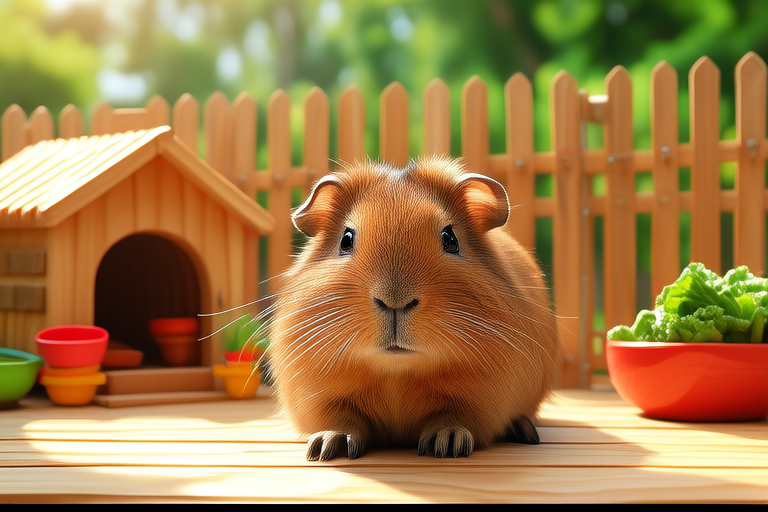How to Create the Ultimate Habitat for Your Lovable Guinea Pig
Welcome to the wonderful world of guinea pigs! These adorable, sociable creatures bring joy and companionship to many households. Providing your guinea pig with a safe, stimulating habitat is crucial for their health and happiness. In this guide, we’ll explore how to create the ultimate habitat for your lovable guinea pig, covering everything from cage size and bedding materials to toys, ventilation, temperature control, feeding areas, hiding spots, and regular cleaning routines.
The Importance of a Proper Cage Size
Adequate space is essential for your guinea pig’s well-being. A small cage can lead to stress, anxiety, and even physical health issues. The general rule of thumb is that each guinea pig needs at least 7.5 square feet (about 108 inches by 72 inches) of living space. If you have multiple guinea pigs, ensure that the total area is proportionate to the number of animals. A larger cage allows them to move around freely, exercise, and engage in natural behaviors like running, playing, and exploring.
Selecting the Right Bedding Materials
Choosing the right bedding is vital for your guinea pig’s comfort and hygiene. Opt for bedding made from soft, dust-free materials that are easy to clean and absorb moisture. Some popular choices include paper-based bedding, recycled paper products, and high-quality wood shavings. Avoid cedar or pine shavings, as they contain aromatic oils that can irritate your guinea pig’s respiratory system. Change the bedding regularly to maintain cleanliness and prevent odors.
Toys for Enrichment and Mental Stimulation
To keep your guinea pig mentally stimulated and physically active, provide a variety of toys. Chew toys help wear down their constantly growing teeth and prevent dental problems. Cardboard boxes, untreated wooden blocks, and safe plastic toys are excellent options. Tunnel systems and hideouts encourage exploration and provide cozy spaces for relaxation. Rotate toys periodically to keep things interesting and prevent boredom.
Ensuring Proper Ventilation and Temperature Control
Guinea pigs are sensitive to extreme temperatures, so it’s crucial to maintain a comfortable environment. Keep the cage away from direct sunlight, drafts, and heat sources. Ideal temperatures range between 65°F and 75°F (18°C to 24°C). Proper ventilation is also important to ensure fresh air circulation. Use wire mesh or screen covers on top of the cage to allow air flow while preventing drafts. If necessary, use a fan or air conditioner to regulate temperature during hot summer months.
Creating Feeding Areas and Hiding Spots
Your guinea pig’s habitat should include designated areas for feeding and resting. A food dish and water bottle are essential for providing fresh, clean food and water. Place the water bottle at a height that allows your guinea pig to reach it easily without straining. Hideouts offer a sense of security and privacy, helping to reduce stress and promote relaxation. Consider using tunnels, igloos, or cardboard boxes as hiding spots. Make sure these areas are easily accessible and cleaned regularly.
Regular Cleaning Routines for Hygiene and Health
Maintaining a clean habitat is key to your guinea pig’s overall health. Regularly remove waste, uneaten food, and soiled bedding. Clean the entire cage at least once a week, thoroughly scrubbing all surfaces with a pet-safe disinfectant. Rinse thoroughly and allow the cage to dry completely before replacing the bedding. Disinfect the water bottle and food dish daily to prevent bacterial growth. Establish a consistent cleaning schedule to ensure your guinea pig remains healthy and happy.
Selecting Accessories for Your Guinea Pig’s Habitat
When choosing accessories for your guinea pig’s habitat, focus on safety, comfort, and functionality. Look for items specifically designed for small pets, ensuring they are free from harmful chemicals and sharp edges. Opt for non-toxic, chew-resistant materials to prevent ingestion hazards. Pay attention to the size and shape of toys, tunnels, and hideouts to ensure they are suitable for your guinea pig’s body type and activity level. Regularly inspect all accessories for signs of wear and tear, replacing any damaged items promptly.
Maintaining Hygiene and Preventing Odors
Odor control is an important aspect of maintaining a clean and pleasant habitat for your guinea pig. Regular cleaning, proper ventilation, and the use of odor-neutralizing products can help minimize smells. Consider using baking soda or activated charcoal to absorb odors naturally. Avoid strong-smelling deodorizers, as they may irritate your guinea pig’s sensitive respiratory system. Additionally, provide plenty of fresh air and ensure that the cage is positioned in a well-ventilated area.
Encouraging Natural Behaviors and Exercise
In addition to providing a spacious cage, encourage your guinea pig to engage in natural behaviors and exercise outside of the habitat. Supervised playtime in a safe, enclosed area allows them to run, jump, and explore. This helps prevent obesity and promotes mental stimulation. Rotate toys and accessories to keep things interesting and encourage exploration. Consider setting up tunnels, ramps, and platforms to create an enriched environment that stimulates their senses and keeps them active.
Monitoring Your Guinea Pig’s Health and Happiness
Regularly observe your guinea pig’s behavior and appearance to ensure they are healthy and happy. A content guinea pig will be active, curious, and responsive to stimuli. Signs of illness or discomfort may include lethargy, loss of appetite, changes in grooming habits, or unusual vocalizations. Consult a veterinarian if you notice any concerning symptoms. Regular check-ups and vaccinations can help prevent common health issues and ensure your guinea pig lives a long, healthy life.
Fostering a Safe and Stimulating Environment
Creating the ultimate habitat for your guinea pig involves more than just providing a cage; it’s about fostering a safe, stimulating environment that promotes their physical and emotional well-being. By paying attention to cage size, bedding materials, toys, ventilation, temperature control, feeding areas, hiding spots, and regular cleaning routines, you can ensure your guinea pig enjoys a happy, healthy life. With the right setup and care, your guinea pig will thrive and bring endless joy to your home.
